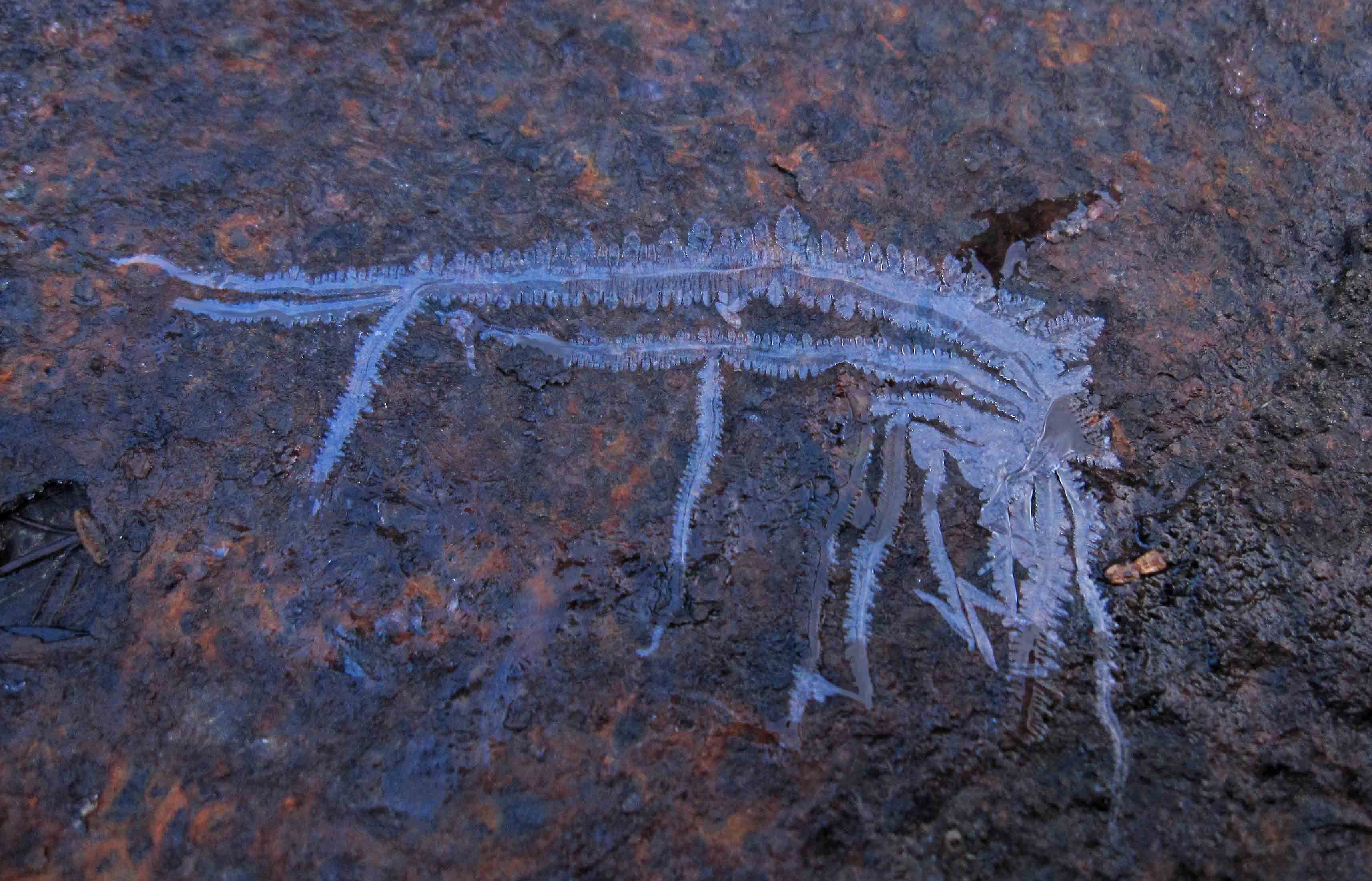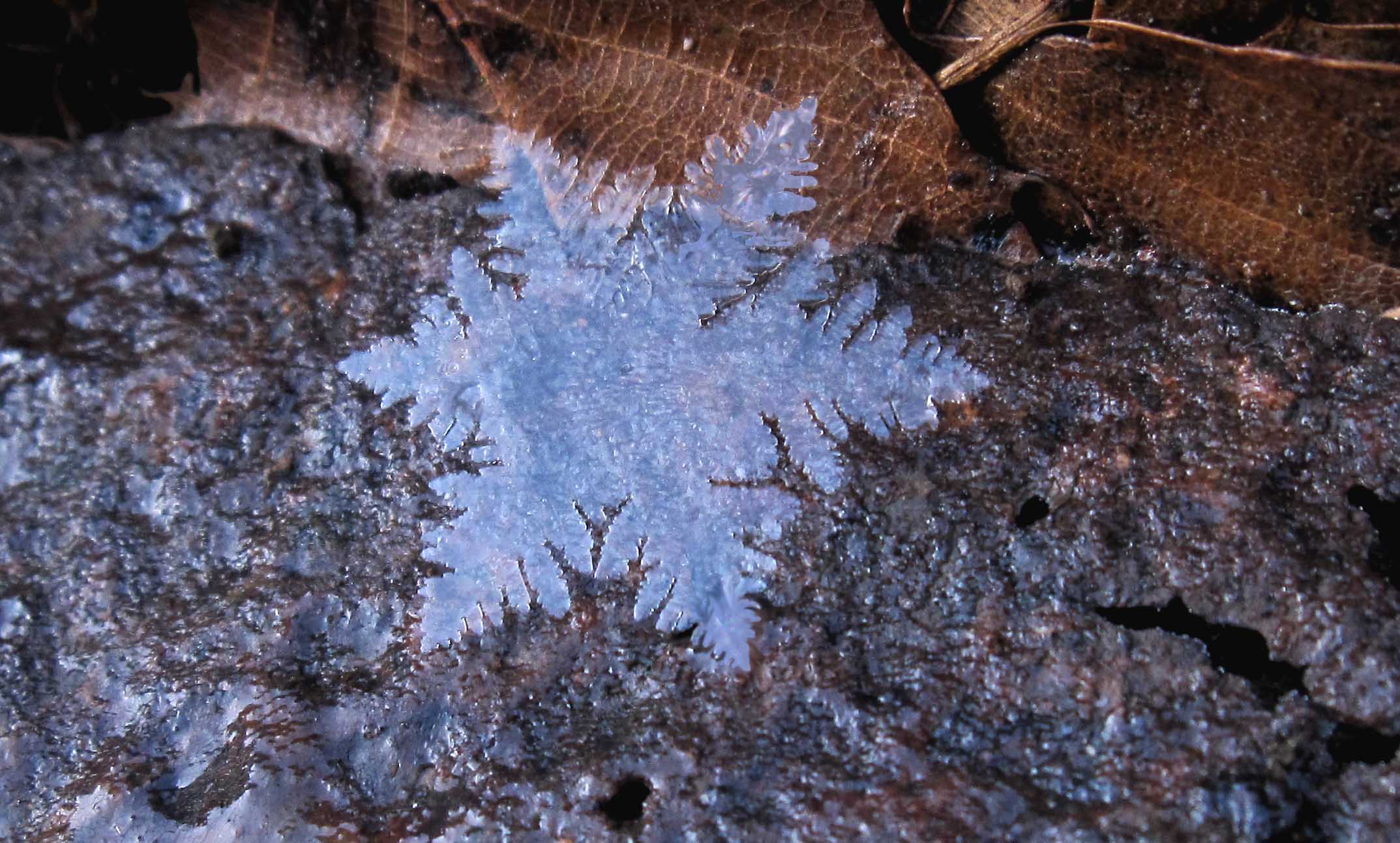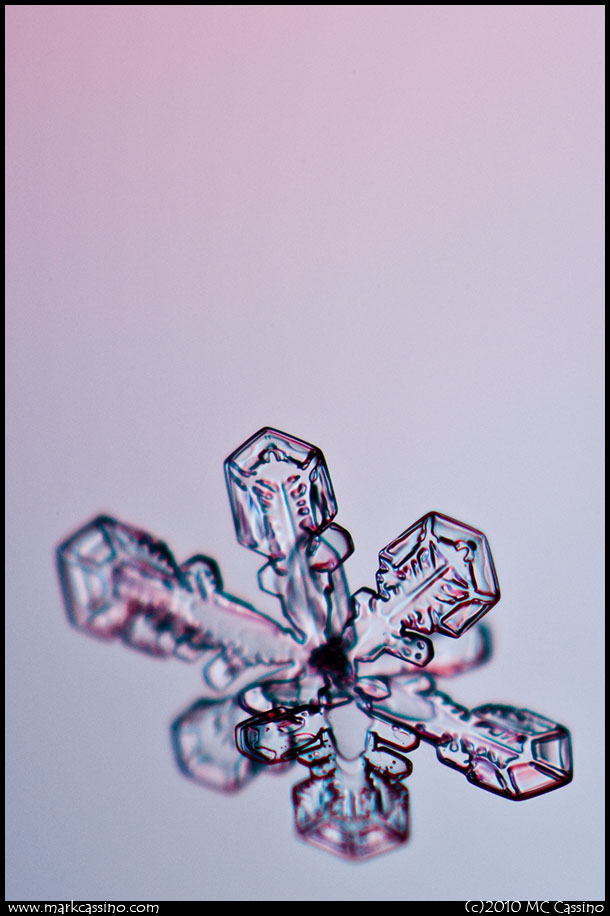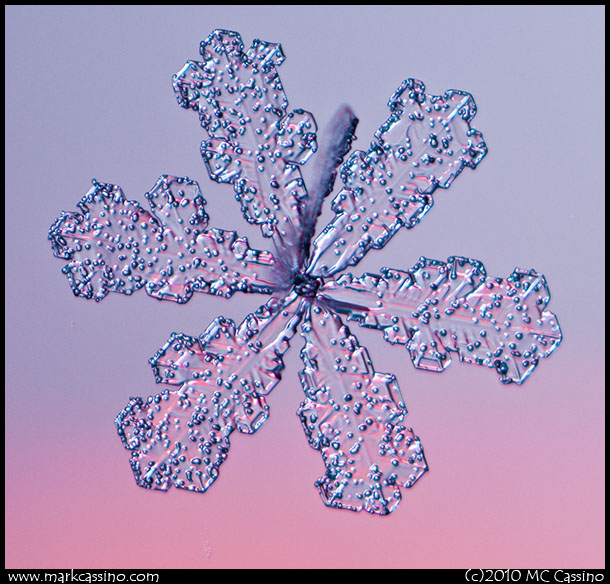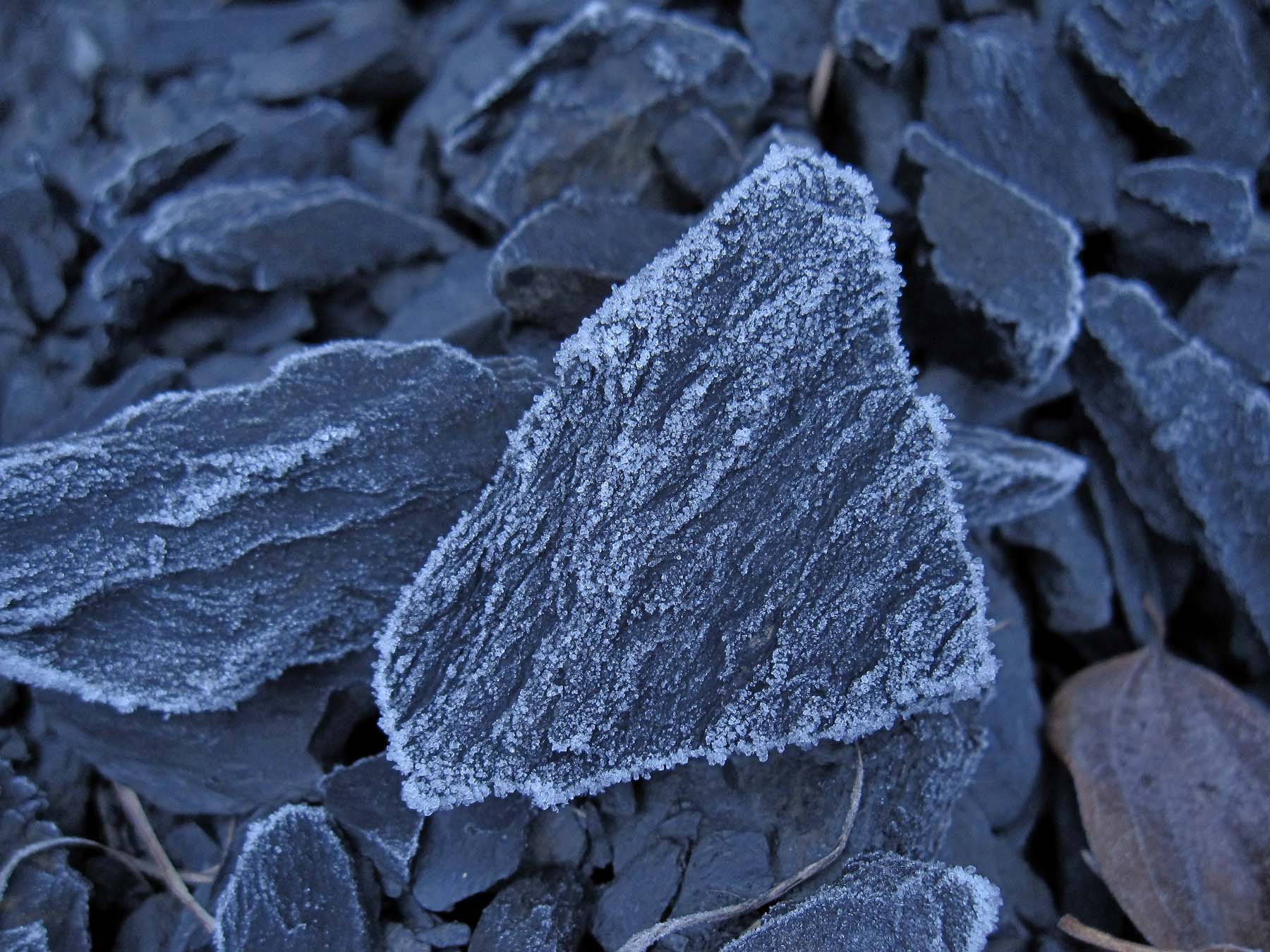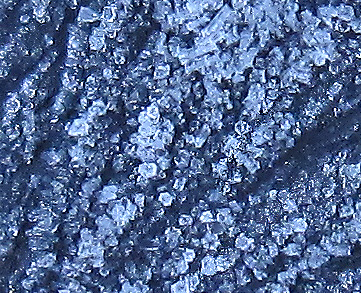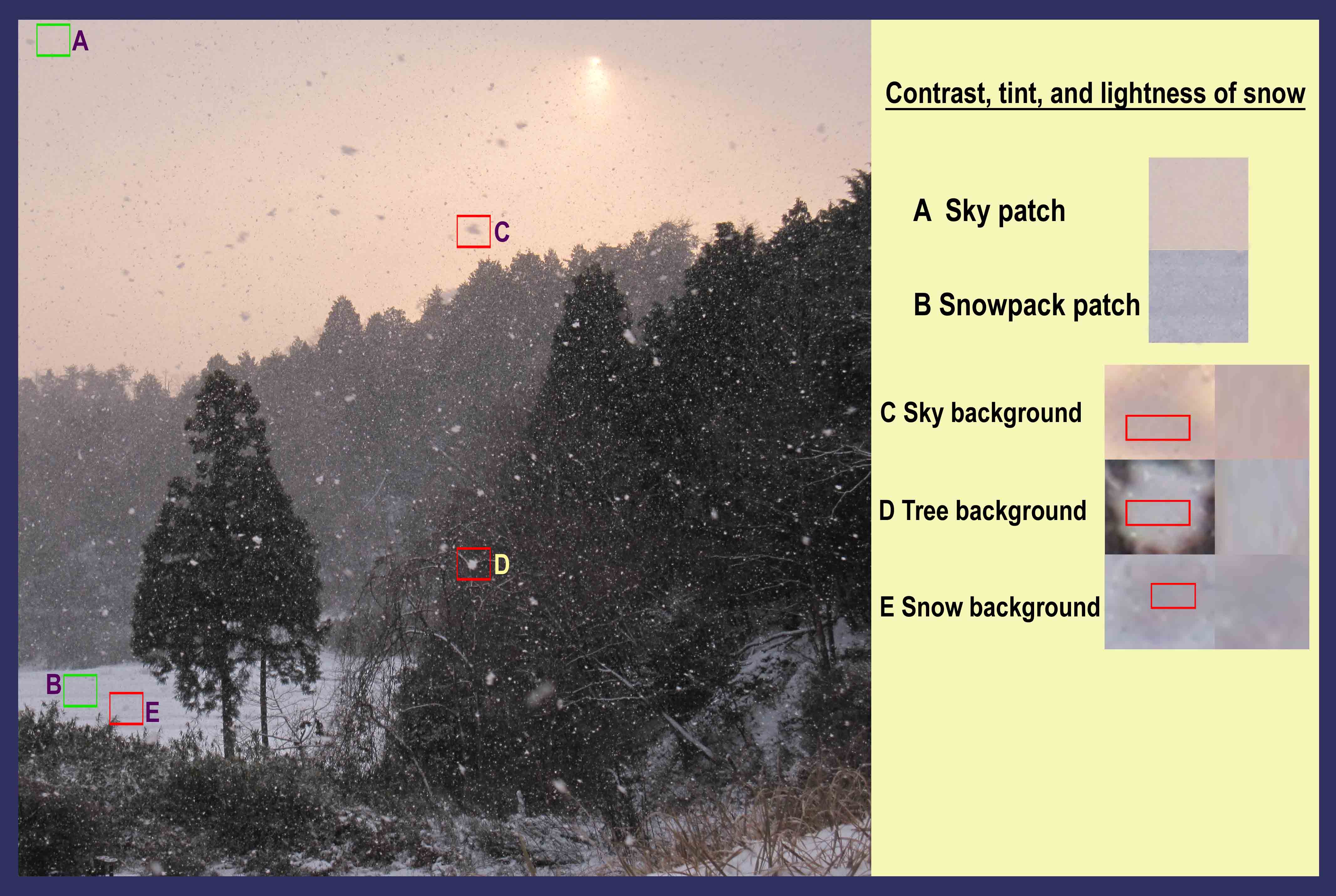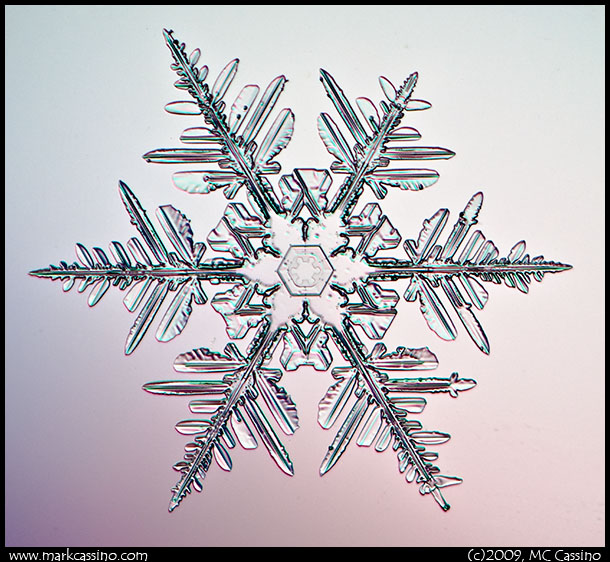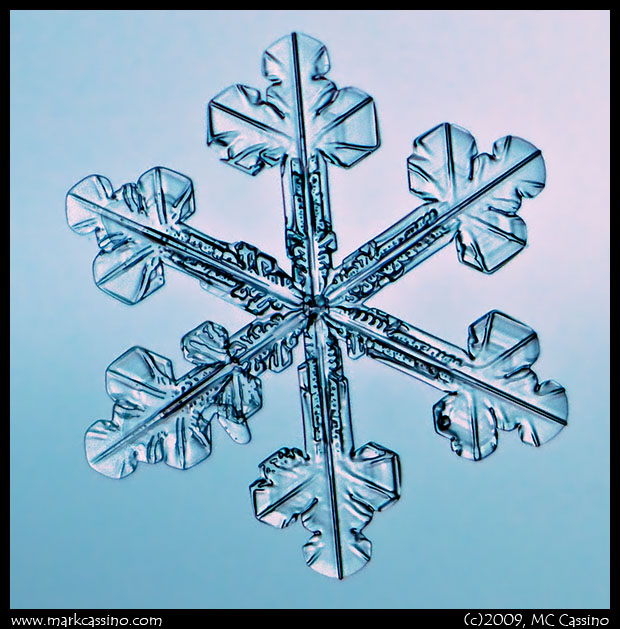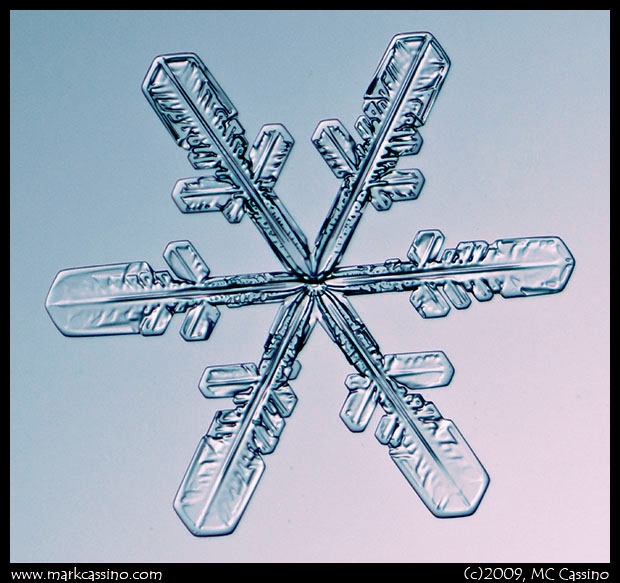They Came From Out of the Tub
January 8th, 2010Last night it rained, but the skies cleared before morning, letting the air temperature drop to about 2 degrees C. The weather, it seemed, would be perfect for lacy white frost patterns on cars. But it didn't quite turn out that way. A little bit before sunrise, I went out on my rounds. I took a few pictures of ice on parked cars and then headed for the rice fields. Neither tub had ice, so I walked to the abandoned car on the other side of the roadway. Nothing of note there either, but in those few minutes a blade of ice had started across one tub. Soon there were several. With a stick, I went under one blade, lifted it up, and noticed the thin serrated fingers that had been growing into the water, hidden under the surface. The disturbance of the water surface caused the growing mesh of ice lines to drift, unattached to the tub walls. I don't see this in puddles. In the puddles, the ice is always anchored to the shore, presumably because the ice starts from the shore, where there are more things to nucleate from.
In the tub I saw a curvy piece and fished it out. Laid out on the rusted lid of a nearby barrel, the ice looked strange, like a fossil of some prehistoric creature.
The critter is about 3-4 inches head to tail and paper thin. As the crystal grew from liquid water, called 'melt' by material scientists, it is said to be "melt-grown". I call such crystals "puddle crystals". Anyway, soon ice was starting on the other tub. Out in the middle of an open patch of water, I saw a small hexagon. With a stick I tried lifting it out. I found that the central hexagon had six large branches that had been hiding just under the surface. But the crystal slipped off my stick and cut under the water's surface - never to be seen again. Needing something better than a stick, I found a piece of a plastic lid that had been left in a nearby ditch and tore off a piece. Then next time I saw a small, isolated hexagon, I lifted it out and put it on the barrel lid. See the photo below.
Though the central hexagon that I could see on the water was less than a half inch across, the full crystal was about one and a half inches across. Curious how the water would cover up all six branches symmetrically... Anyway, despite the large width of our 'puddle star', it too is paper thin. And being so flat and featureless on both sides, it evenly reflects the bluish skylight. The serrated pattern on the branches make this crystal a dendrite, like the dendritic snow crystal. But a puddle crystal grows much faster than a snow crystal because the melt (i.e., liquid water) is more densely packed with water molecules than the air from which snow grows. Also, when a snow crystal branch grows, it removes water vapor from the nearby air. This depletion of vapor is most severe near the base of the branches, and thus snow-crystal branches hardly widen - they mainly grow at the tip and at the tips of the side-shoots (called side-branches). But the melt is never depleted of water molecules, so the branches of puddle crystals keep widening until they merge. Another difference between puddle crystals and snow crystals is that puddle crystals viewed broadwise have a curving outline. The snow crystal usually has a polygonal outline, that is, made from straight lines.
- JN
New Reviews in The Washington Post and the Fort Worth Star-Telegram
January 7th, 2010Here are two new reviews of The Story of Snow:
Washington DC has seen a bit of snow of late, on the heels of that the Washington Post says "The engaging "Story of Snow" -- featuring a succinct text, spare illustrations in gray-and-blue hues and magnified images of gorgeous snow crystals -- explains how snow is made ..." The full review is here:
Down in Texas they see a little less snow, but currently are experiencing a cold snap. Maybe it's a chance to take a close look at some snow crystals. The Fort Worth Star-Telegram has this to say about The Story of Snow: "Part science, part art, this beautiful book explains a bit of the chemistry behind winter’s cold, white precipitation and also features startlingly detailed and amazing photos of ice crystals..." The full review:
http://www.star-telegram.com/family_day/story/1870342.html#tvg
A bit of snow is in the forecast for SW Michigan, so I have my fingers crossed.
- Mark
A Few More Lighting Experiments
January 6th, 2010I'm continuing to work on taking snow crystal photos to the next level. It's funny because in past years I tried different approaches to lighting, and none of them worked. So it was a surprise when I picked up a couple of spare C9 holiday lights, dropped them on the flash, and suddenly saw a whole new range of colors in the snow crystals.
I tried similar things in the past, but they just haven't worked. Then I realize that I've been fiddling with the exact placement of the flash beneath the coffee can that holds the glass plate full of snow. Adding the colors, combined with the way the light from the flash was bouncing around inside the coffee can, did the trick. Insanity has been described as doing the same thing over and over, hoping for a different result. But sometimes it turns out, you're not really doing the same thing and you may have learned something new, even if you don't know it.
Now, if only the snow would cooperate. Here are three shots from last night. The lake effect bands have been running to the west of Kalamazoo these last few days. Every now and then one drifts our way and brushes against the city. If I'm lucky I get half an hour, maybe a little longer, before the band of falling snow wanders back. Unfortunately, the snow that has been falling hasn't been the most photogenic.
The crystal at the top of this post landed on its side. I knew that it would exceed the camera's depth of field, but I liked how it looked in the finder. It's easy to imagine the crystal falling through the atmosphere. Below is a simple crystal that has a 'spur' (as I'll call it) growing perpendicularly out of the center. I see many of these - I'm not sure why they form. The crystal is also spotted with rime.
Lastly - here's another double crystal, similar in basic structure to the one I posted on 12/27, but with much greater difference in size between the two crystals that make it up. As always, click on an image for a larger view.
Let's hope for more snow, soon!
MarkThe Crystalline Beard
January 5th, 2010I have very often in a Morning, when there has been a great hoar-frost, with an indifferently magnifying Microscope, observ'd the small Stiria, or Crystalline beard, which then usually covers the face of most bodies that lie open to the cold air, and found them to be generally Hexangular prismatical bodies…
The above passage, from Robert Hooke's Micrographia (1664), describes almost exactly what I do on sufficiently cold winter mornings. Though I don’t have a microscope, I have a Canon Power Shot camera with the macro feature that allows me to zoom in on tiny objects. (The best gift I ever got, and possibly the best thing an amateur naturalist like me could ever receive.) From afar, most hoar frost looks similar – a dusting or coating of white on any surface that can cool enough for vapor to deposit. The effect on an object can be beautiful, looking like an artist has applied a white highlighter to the small protrusions and ridges on the object, as in the rock below.
The rock is about an inch and a half across. The crystals range in size, but the larger ones are about as wide as three thick hairs (300 microns) laid side-by-side. One can see in the enlargement below that many of the crystals have a hexagon shape – like a snow crystal.
A better example showing hexagonal crystals is in the frost I saw on the roof of a black car a few days ago.
White Snow, Black Snow, Pink Snow, Blue Snow
January 3rd, 2010Hands down, my favorite book for browsing is M. Minneart’s The Nature of Light & Color in the Open Air. This small, easy to carry (and cheap if you get the Dover edition) book has 233 short sections on things one can see 'in the open air'; for example, twinkling of stars, the color of lakes, and the rainbow. Section 93 is on black snow, in which he notes how the apparent whiteness of a falling snowflake seems to change from blackish to whitish when the flake’s background changes from the grey sky above to a darker background below (such as dark-green trees). It is a simple enough observation, but I didn’t bother looking for it until a few years ago. Indeed, the illusion of whiteness change is strong. Look for it next time you go out when it's snowing.
On a walk on Jan. 2, I took the picture below because I thought the sun poking through the cloud was interesting, and then later realized that I could easily compare the whiteness of the flakes. Minneart's next section describes a related contrast illusion that also can be tested in the picture - the feeling that the snow on the ground is brighter (or whiter) than the sky above. See if you can shake this illusion next time you go out in the snow.
The sky in the picture is not uniformly grey, as Minneart assumes in his discussion, but is a yellowish-red at and below the level of the sun. So, for the comparison of the sky brightness to the snow brightness, I chose a patch of sky of sky at the place within the green box marked 'A' in the upper left, where the sky is darker. (To see this and other boxes, you can click on the picture to enlarge it.)
Happy New Year 2010
January 1st, 2010A nice lake effect snow blew in early this morning to greet the new year. I spent a little time photographing out in the garage. It's a new year so I tried a couple of new ideas for lighting the snow crystals - this one worked! Not much else to show for the morning's shoot, and by 10 a.m. the snow had stopped and has not yet returned. Hopefully there will be more chances later this weekend. As always, click on the image for a larger view.
-- Mark
Feedback from the Blogosphere
January 1st, 2010Here are three reviews of The Story of Snow that have appeared in the blogosphere over the last month (plus a few days):
Abby (the) Librarian describes the books as "beautiful and interesting" and discuses pairing it with Snowflake Bentley when teaching about snow and winter. You can find the full review here:
http://abbylibrarian.blogspot.com/2009/12/book-review-story-of-snow.html
The Miss Rumphius Effect - a blog aimed at teachers and educators - reviewed Snowflake Bentley and The Story of Snow both in a common post. The Story of Snow was described as "visually appealing and highly informative." You can see the whole review here:
http://missrumphiuseffect.blogspot.com/2009/12/nonfiction-monday-let-it-snow.html
A Patchwork Of Books comments that the book "takes every day questions about snow and answers them with a simple, yet informative method." You can read the whole review here:
http://apatchworkofbooks.blogspot.com/2009/11/non-fiction-monday-time-for-snow.html
There may be more out there but those are ones I ran into. Thanks to everyone who reads the book and takes the time to offer feedback!
- Mark
Feedback from the Blogosphere
January 1st, 2010Here are three reviews of The Story of Snow that have appeared in the blogosphere over the last month (plus a few days):
Abby (the) Librarian describes the books as "beautiful and interesting" and discuses pairing it with Snowflake Bentley when teaching about snow and winter. You can find the full review here:
http://abbylibrarian.blogspot.com/2009/12/book-review-story-of-snow.html
The Miss Rumphius Effect - a blog aimed at teachers and educators - reviews Snowflake Bentley and The Story of Snow both in a common post. The Story of Snow was described as "visually appealing and highly informative." You can see the whole review here:
http://missrumphiuseffect.blogspot.com/2009/12/nonfiction-monday-let-it-snow.html
A Patchwork Of Books comments that the book "takes every day questions about snow and answers them with a simple, yet informative method." You can read the whole review here:
http://apatchworkofbooks.blogspot.com/2009/11/non-fiction-monday-time-for-snow.html
There may be more out there but those are ones I ran into. Thanks to everyone who reads the book and takes the time to offer feedback!
- Mark
Not the Worst Winter Ever
December 29th, 2009The winter of 2009/10 is still quite young, and no one knows what it holds. But at this early date there is one thing I can say for sure - when it comes to snow crystal photos, it won't be the worst winter ever.
I don't feel like digging into my records to figure out which season exactly was the worst. I first started photographing snow crystals in 1997, and the first few years I worked on it were a real challenge - especially shooting very unforgiving color slide film. But there was one year when, even with digital cameras and a refined and predictable technique, I only managed two good shots. It's just a question of what nature tosses your way, and if you are there to receive it.
That is part of the deal with nature photography. You take what the earth gives you. Sometimes it is generous; often not. And when not, you just get up and go back out, faithful that things will be different. Whether it's hunting for snow crystals, visiting a pine barrens, hoping to find wildflowers or dragonflies - sometimes nature is bountiful, sometimes not. And often you come home with nothing to show for the effort.
Some days I wish that it all could be easy. Maybe I could fly to places where the subjects I want to photograph are right there waiting. I'm sure dragonflies are on the wing somewhere. Snow crystals fall in perfection someplace else. Sometimes I feel that I lack dedication, and if I was really serious I would not just shoot photos in my little corner of the world, but rather would go where the subjects are and really produce. It could be easy... and rewarding.
But if I have learned anything from observing nature, it is that the easy is the most unnatural. And if I have learned anything from art, it is that the product is a distraction and it is the process that is the most compelling. So while bleak winter days can be unrewarding; while a whole winter can pass and yield just two snow crystal photos; while there are days I return empty handed, again; and nights dark with doubt - ultimately it is part of the dance, part of the process, part of creation. No matter what, it's a blessing and not to be denied just because there is nothing to show for it.
Yeah - I know - try explaining that to folks who say "But what did you do today?" So I am happy to record in my journal - "2009/10 is not the worst winter ever wrt snow crystals."
And so here we go - two more shots from Sunday night, embedded in this post. As always - click on the image for a larger file.
The session was not quite as productive as I had hoped, but there is at least another shot in the works and what the heck - did I mention that this is not the worst year ever when it comes to snow crystals?
New Review On Bookends, a Booklist Blog
December 29th, 2009Yesterday, a new review of The Story of Snow appeared on Bookends, a Booklist blog.
Here’s an excerpt:
“They take a rather technical subject and make it “crystal” clear for really young readers and still retain a tangible sense of wonder. This is a beautiful book and a fascinating book.”
You can read the whole thing here:
http://bookends.booklistonline.com/2009/12/28/the-story-of-snow-by-mark-cassino-with-jon-nelson/
